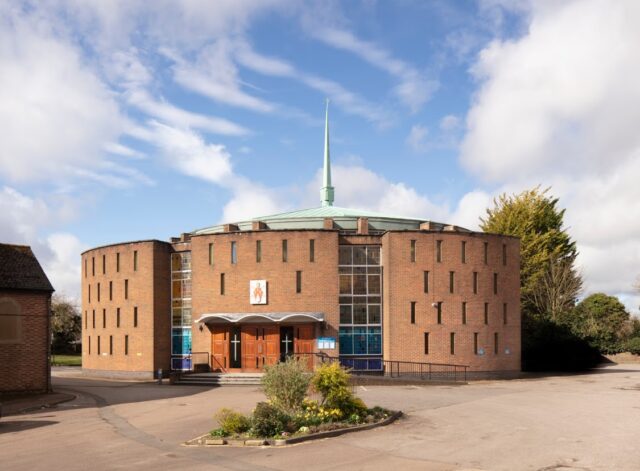Roman Catholic Church of St Mary, Dunstable, Bedfordshire – listed at Grade II
1960s church with a highly unusual tetrahedral blue and white ceiling designed like a medieval fan vault which also serves to stop reverberation
The Roman Catholic Church of St Mary in Dunstable was built in 1962-1964 to the design of innovative English architect Desmond Williams OBE. He is known for his striking church buildings at a time of great change in ecclesiastical architecture during the late 1950s and early 1960s. This reflected the cultural changes in England at the time. Very few changes have been made to the church, and the circular plan breaks with convention. It is an early example of the impact of the Liturgical Movement on church design with its highly unusual blue and white ceiling following the form of a medieval fan vault. This type of ceiling also has a practical function to stop reverberation (echo) around the church. The ecclesiastical architecture includes features which are grouped in numbers that have biblical significance. For example, there are 12 bays running around the outside of the church which could relate to the 12 tribes of Israel or the 12 Disciples. The doorways into the church occur in threes, which often relates to the Holy Trinity.
Nunn’s Bridge, Coggeshall, Essex – listed at Grade II
Picturesque late 19th century footbridge funded and constructed by social activist Henry ‘Dick’ Nunn, an early advocate of rights of way in the countryside
Nunn’s Bridge is a simple but elegant wrought iron footbridge that spans the River Blackwater near Coggeshall. Erected in 1892, it is unique in its design, craftsmanship and installation by skilled local blacksmith and social campaigner Henry ‘Dick’ Nunn. The previous wooden footbridge, which acted as a public footpath, fell into decay in 1875 and was eventually washed away. Nunn appealed to the local authorities to replace the bridge, but to no avail, and thereafter declared his intention to fund and construct a bridge himself, such was his strong wish to see the footpath remain open to the public. Nunn was a locally well-known and popular campaigner for the welfare of people and animals, and an early advocate of rights of way in the countryside; importantly, his activism predates the establishment of the National Trust in 1895 and the Ramblers’ Association in 1935. The picturesque bridge now stands as a symbol of Nunn’s generosity and social activism, and the burgeoning necessity for access to the countryside at the end of the 19th century.
Remains of Apsidal Roman Building, Colchester – protected as a Scheduled Monument
The standing and buried archaeological remains of a late Roman building give an insight into life in historic Colchester
The remains of an apsidal – or rounded “apse” ended – building have been interpreted by some as a very early church, by others as a funerary banqueting hall, and more recently as a possible mithraeum (a cave-like temple dedicated to the god Mithras). The apsidal end was first uncovered in a Colchester resident’s back garden in 1839.
Since 1915, studies and various excavations of the site have contributed to our knowledge and understanding of the building, its place in Roman Colchester and in the wider Roman landscape.
The city of Colchester was the Roman city of Camulodunum, originally the Roman provincial capital before the Boudican rebellion in AD 60-61, when the capital moved to Londinium. Colchester continued to be a Roman town of great importance, and contained the only known Roman Circus in Britain.
The well-preserved remains of this mysterious building include upstanding masonry and enough of the footprint for us to be able to clearly see the form of the building. Scholars still debate what it was used for, to this day.
The Pondyards, Gorhambury, St Albans Hertfordshire – protected as a scheduled monument
Series of influential water gardens created in the early 1700s for English philosopher Francis Bacon
The Pondyards at Gorhambury are a series of water gardens that were created in 1608 for Sir Francis Bacon, the English philosopher and statesman who counselled Queen Elizabeth I and King James I. These water features, which were designed to display aquatic plants or ornamental fish, were extremely popular among the courtiers of Renaissance England, and were developed as a landscape artform.
The foundations of the Pondyards are in good condition and it is thought that archaeological items may still survive within the banks and base of the ponds. The Pondyards are in Bacon’s Hertfordshire estate (now the Grade I listed ruins of Old Gorhambury that was built by his father, Sir Nicholas Bacon). Our understanding of their origins, history and influence on future landscaping is helped by surviving historic documentation such as drawings, written descriptions and even Bacon’s own essay about garden design.
1, 3 & 5 Park Street, Old Hatfield, Hertfordshire – upgraded from Grade II to Grade II*
Rare survival of two 17th century wall paintings leading the way towards home decoration as we know it today
1, 3 & 5 Park Street has had many uses over the years, most likely beginning as an inn in the mid-17th century, before it became a home, followed by shops and most recently offices in the late 20th century. The surviving historic fabric of the building has many notable features, such as square panelling and a late 17th century oak staircase. Most importantly, the very rare survival of two 17th century wall paintings have recently been unveiled, providing valuable insight into the history of how people once decorated their homes. The murals, which portray grotesques and a pattern that imitates a cloth-like texture, are in excellent condition and seem of particularly high quality for a building of this kind.
Beauchamp Lifeboat Memorial, Caister-on-Sea, Norfolk – listed at Grade II
The origin of the term ‘Never Turn Back’ – RNLI
Beauchamp Lifeboat Memorial, sat in the East and West Caister Village Cemetery, was unveiled in 1903 to remember the nine crew members who lost their lives during a rescue mission in 1901 that gained national attention.
Caister has had a long-running lifeboat history, with the first lifeboat being sited there by the Norfolk Shipwrecked Mariners Association in 1845. The Beauchamp lifeboat was brought into service in 1892 and had a previously excellent track record during its nine years of service. On a treacherously stormy night in 1901, the Beauchamp was launched in response to distress signals coming from a ship towards Barber Sands. Despite the severity of the storm, the crew managed to get the boat afloat and begin their mission. However, the boat capsized en route, trapping the crew beneath and taking nine lives. When asked, during the inquest, why they persevered, the three surviving crew responded: “Going back is against the rules when we see distress signals like that”, which the press abbreviated to “Caister men never turn back.”
As well as a moving tribute that recognises the crew’s bravery and sacrifice for their local community, with their names and ages engraved on blocks around the base, the memorial is sculpturally notable. The broken mast, anchor, lifebuoy and laurel wreaths act as a visual reminder of the tragic loss of life at sea.
Ketts Castle Villa and Garden, Norwich, Norfolk – listed at Grade II
A little-altered villa built in 1857 for, and believed to be designed by, the painter John Berney Ladbrooke
Ketts Castle Villa was designed for, and probably by, the landscape artist John Berney Ladbrooke (1803 -1879). He was an artist in the Norwich school of painting, a British landscape movement founded in 1803 by a small group of self-taught, working class artists based around Norwich, including his father, Robert Ladbrooke.
The school’s work included landscapes and scenes of rural life, which some commentators have described as a forerunner to both French Impressionism and also to the Newlyn School of Painting in Cornwall.
Ketts Castle Villa was built in 1857 for the artist in his maturity. It is likely that he chose the location of his house for the commanding view down to the city of Norwich. The artist’s studio tower offers panoramic views towards Norwich, the trees in the garden below and the distant ruins of St Michael’s Chapel to the west.
Ladbrooke created a steep hillside garden incorporating fragments of reused medieval masonry, believed to be the remains of the nearby St Michael’s Chapel and possibly St Leonard’s Priory. A romantic landscape on a domestic scale, it features lawned gardens, a terrace and a serpentine path.
Japonica and The Nook and Former Post Office and Store, Somerleyton, Suffolk – listed at Grade II
Picturesque mid-19th century estate buildings created for English entrepreneur, civil engineer and contractor Sir Samuel Morton Peto
In 1844, Somerleyton Estate was purchased by Sir Samuel Morton Peto (1809-1889), a remarkable man who started his career as a bricklayer before becoming a leading building contractor and the largest employer of labour in the world.
He won many notable contracts, including those for the Houses of Parliament and Nelson’s Column, and he built many of the railways in Britain and throughout the world. He was an MP and one of the guarantors for the Great Exhibition of 1851. He was knighted in 1855 and his son, Sir Savile Crossley, became the first Baron Somerleyton in 1916.
Peto employed John Thomas (1813-1864) to rebuild Somerleyton Hall (Grade II*), the parish church (Grade II*) and the picturesque estate cottages around the village green, all of which are listed at Grade II. He built the former Post Office and Store and it is highly likely that Thomas also designed the semi-detached estate workers’ cottages called Japonica and The Nook.
Primarily a sculptor and ornamental mason, he was appointed Superintendent of stone-carving at the Palace of Westminster in 1846 and in 1848 was commissioned by Prince Albert to produce large bas reliefs of ‘Peace’ and ‘War’ at Buckingham Palace. Further work at Windsor Castle followed, together with a sculptural programme for the Sultan’s Palace at Constantinople.
The former post office and store was built around 1848-1857 in red brick laid in Flemish bond with yellow brick dressings and a roof covering of plain red clay tiles. It was converted into a dwelling and bicycle hire shop in 2017. Japonica and The Nook were built in the 1850s in a picturesque Tudor vernacular style.




